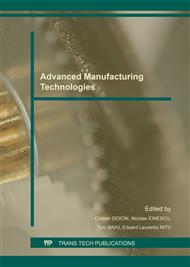p.102
p.108
p.114
p.120
p.126
p.132
p.141
p.147
p.153
On Overlapping the Pulses on Cumulative Microjets Stage at Ultrasonically Aided Electrical Discharge Machining
Abstract:
The paper deals with a solution to increase the machining rate at electrical discharge machining aided by ultrasonics (EDM+US), i.e. the overlapping the voltage pulses provided by EDM generator on the cumulative microjets stage (CMS), which occurs at every final of an ultrasonic period by collective implosion of the gas bubbles from the working gap. This overlapping moves the limit of the removed material by a discharge from the boiling isothermal (at classic EDM) to melting isothermal (at EDM+US) as it is emphasized by the results of finite element analysis. The preliminary experimental data analyzed in the paper are obtained in case of random overlapping at ultrasonic frequency of 20 kHz. They demonstrate an increase of machining rate with more than 300% at EDM+US in comparison with classic EDM in the same working conditions.
Info:
Periodical:
Pages:
126-131
Citation:
Online since:
April 2016
Authors:
Price:
Сopyright:
© 2016 Trans Tech Publications Ltd. All Rights Reserved
Share:
Citation:


